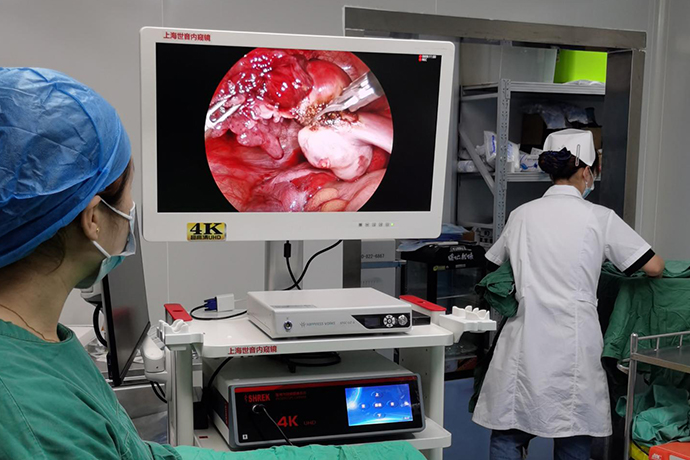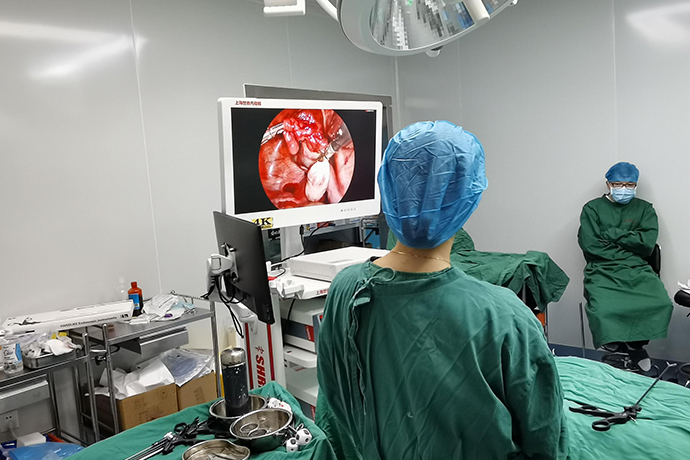[Gynecological Laparoscopy] 4K laparoscopic treatment of ectopic pregnancy
Release time: 27 Jun 2023 Author:Shrek
What is an ectopic pregnancy?
Ectopic pregnancy is a popular saying, medically known as ectopic pregnancy, is a gynecological emergency. It means that the fertilized egg does not implant in the uterus, but stays outside the uterus, such as fallopian tubes, ovaries, and cervix. If left untreated, it can endanger the life of the pregnant woman. Therefore, women should go to the hospital for a comprehensive early pregnancy check within six weeks after menopause to prevent ectopic pregnancy.

Why do ectopic pregnancies happen?
Under normal circumstances, sperm and eggs are combined in the fallopian tube to form a fertilized egg, and then fall from the fallopian tube to the uterus for implantation. However, once the fallopian tube becomes inflamed, the way forward for the fertilized egg is blocked; or there is damage in the uterus, Not suitable for implantation of fertilized eggs. The fertilized egg will naturally develop in situ or "find another job", which forms an ectopic pregnancy.
What are the common symptoms of ectopic pregnancy?
1. Menopause:
An ectopic pregnancy is also a pregnancy, and it will stop menstruation just like a normal pregnancy. Therefore, if women who have sexual life have delayed menstruation, it is recommended to go to the hospital for examination to determine the reason for the lack of menstruation.
2. Abdominal pain:
The main symptom of most patients with tubal pregnancy is abdominal pain. Before miscarriage or rupture of tubal pregnancy, the embryo gradually grows in the fallopian tube, and one side of the lower abdomen may feel dull pain or soreness.
3. Vaginal bleeding:
If a female friend is detected to be pregnant and has vaginal bleeding, she must be careful at this time. This may be an ectopic pregnancy.
4. Syncope and shock:
Light ones often suffer from syncope, and severe ones suffer from shock.
How to do ectopic pregnancy surgery?
the
Ectopic pregnancy is an abnormal pregnancy process in which a pregnant egg implants and develops outside the uterine cavity. The surgical treatment is divided into two types, namely minimally invasive laparoscopic surgery and laparotomy.
1. Laparoscopic surgery is a minimally invasive surgery, which not only has less trauma, quick postoperative recovery, but also fewer surgical complications. It is the main method for treating ectopic pregnancy. The cutting-edge technology of 4K ultra-high-definition laparoscopy does not require laparotomy, and the cavity can be viewed through ultra-large ultra-clear monitor images, helping doctors to better see the lesion, reducing surgical risks, and shortening the operation time. Single-port laparoscopy can also be used for several small circular scars, which will not affect the appearance. Because the trauma is small, the pelvic organs of the postoperative patient are not easy to adhere, and the pregnancy rate of postoperative patients is higher than that of those who underwent laparotomy.
2. Laparotomy: A 6-8cm incision is made in the lower abdomen. The incision is painful when the patient moves after the operation, and the recovery is slow.
laparoscopic surgery
Artificial pneumoperitoneum
With the patient in the supine position, cut the skin at the lower edge of the umbilical foramen, lift the abdominal wall, puncture the abdominal cavity along the incision, connect the carbon dioxide pneumoperitoneum needle, and carry out carbon dioxide inflation. 12-15mmhg, pull out the Veress needle.
Place laparoscope
Lift the abdominal wall and insert the puncture device along the skin incision. When there is a sense of breakthrough, turn on the camera system and cold light source, put the laparoscope into the abdominal cavity, connect the insufflation machine after seeing the pelvic organs, and start the operation under the microscope.
laparoscopic surgery
Fallopian tube fenestration embryo retrieval
1. Non-destructive grasping to expose the tubal pregnancy site.
2. Then cut the fallopian tube at the weakest part of the pregnancy mass. If the fallopian tube has ruptured, extend the incision at the breach.
3. Hydraulic separation to take out the lumen pregnancy tissue and blood clot.
4. Repeatedly flush the lumen with normal saline to avoid villi remaining.
5. If there is no active bleeding in the fallopian tube, it can heal itself without suturing.
Fallopian tube umbrella compression or incision
1. Clamp the ampulla of fallopian tube under laparoscope.
2. Squeeze repeatedly to the umbrella part several times to squeeze out pregnancy products and blood clots from the umbrella part.
3. Flush the umbrella of the fallopian tube to remove the blood clot.
Radical surgery
1. Expose the tubal pregnancy site.
2. Removal of diseased fallopian tubes.
3. Ligation to stop bleeding.
Suture
After the endoscopic operation was completed, the peritoneal cavity was flushed with normal saline, and no bleeding or organ damage was checked. After the carbon dioxide insufflation was stopped, the laparoscope and various instruments were taken out and the carbon dioxide was discharged, and the puncture was sutured.
Can I conceive naturally after an ectopic pregnancy?
As long as there is one side of the fallopian tube, you can conceive and have a child in the future. According to previous case statistics, after an ectopic pregnancy, the chance of another ectopic pregnancy is about 10%, which is higher than normal, but 90% is still a normal intrauterine pregnancy.
If there are multiple ectopic pregnancies, another option is to have both fallopian tubes removed and then consider IVF at a later date.
Of course, because ectopic pregnancy is often related to pelvic inflammation, the proportion of infertility in these groups is relatively high, which has nothing to do with the treatment of ectopic pregnancy, but with their own basic diseases.
Postoperative instructions?
Minimally invasive surgery for ectopic pregnancy, due to different surgical methods, the time spent in the operation is slightly different, and it is generally completed in about 1 hour. However, the situation during the operation is ever-changing, and the specific operation time should prevail; the patient's waking time after the operation According to the patient's physical condition, dosage, anesthesia method, etc., the patient can basically wake up within half an hour to one hour.
Minimally invasive surgery can go down to the ground in about 6 hours; the anal exhaust time is generally about 10 hours, and patients who recover from exhaustion can eat (mainly liquid food such as porridge and rice porridge); they can be cured and discharged after 3 to 4 days in hospital ; 1 week and 2 weeks after the operation, follow-up consultation in the gynecology clinic, gynecological color Doppler ultrasound, biochemical blood test and other examinations.
What is the preventive method?
The first principle of preventing ectopic pregnancy is to actively prevent and treat pelvic inflammatory diseases and reduce the incidence of chronic salpingitis; for patients who have already had ectopic pregnancy, there is currently no way to prevent another ectopic pregnancy. If you want to conceive, you can try pregnancy under the guidance of a doctor and closely monitored. Women who use intrauterine device contraception should have regular checkups as required to find pelvic inflammation and treat it in time; for those with genital tumors, the location and nature of the tumor should be clarified, and the tumor should be treated reasonably in accordance with the doctor's advice, so as to strive for the best reproductive prognosis. Healthy women, pay attention to the health of sexual life, reduce the chance of external infection, reduce the chance of pelvic inflammatory disease, relatively speaking, it may be less.

- Recommended news
- 【General Surgery Laparoscopy】Cholecystectomy
- Surgery Steps of Hysteroscopy for Intrauterine Adhesion
- [Gynecological Hysteroscopy] Techniques for Preventing and Treating Complications of Hysteroscopic Surgery
- [Gynecological Hysteroscopy] Hysteroscopic Adhesiolysis
- [Gynecological Hysteroscopy] IUD Removal under Hysteroscopy